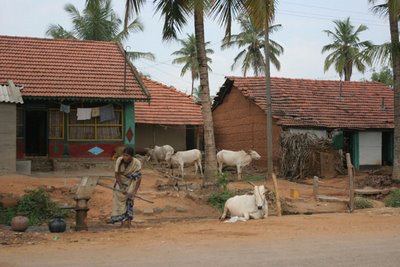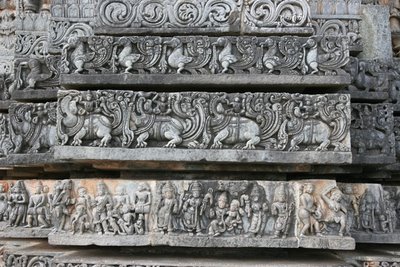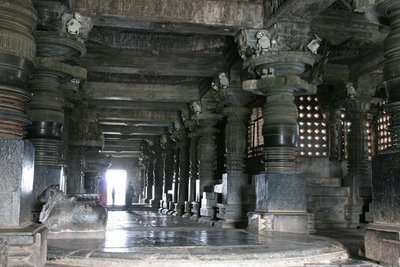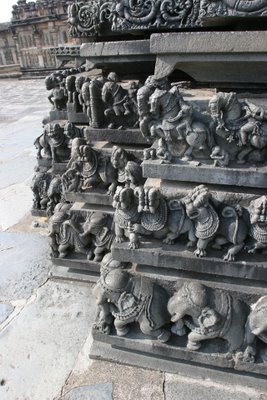
Most of the raw un-stabilized earth houses seemed to be holding up quite well. (even the poorly constructed houses) Now, contrast the modest earth home to this gaudy concrete house. OK, it is fugly. But if that is what floats your boat, it could be executed in earth for less than concrete. I wonder if the person who contracted this abomination knew all the options what they would have chosen. They would have had so much more in left in their budget for tacky trim if they'd gone with earth...

After seeing the damage on the poorly constructed earth houses, I can see how they may have contributed to the seemingly poor reputation of earth. First of all, earth construction is associated with poverty. "Poor as dirt"... and all that. Second, it seems you only ever notice the earth houses that are falling apart, never the houses just next door that are holding together just fine. For some reason, people can look at a dilapidated wood house and not conclude that wood is at bad building material. But earth doesn't seem to get that sort of slack.
Now that I've done the earth building course I'm well acquainted with the various strengths and weaknesses of earth as a building material. As I drive though India I see so many places where concrete and fired brick is being used for basically no reason at all other than convention. Earth would do the job just fine. I'm even talking about multi-story buildings, which all seem to be ferro-concrete with brick infill. The brick is just a complete waste. They could do things in a similar way but with a different material and save money and energy in the process. Speaking of saving energy, the ferro-concrete/ brick in-fill buildings I mentioned must be TERRIBLE energy wasters. I'm sure that eventually, many of them will have some sort of air conditioner installed. They don't appear to have any insulation at all and the thermal gain of the brick is terrible. Earth would not be much better in this regard, but it wouldn't be any worse. And with earth one could afford to make the walls more massive. (Which helps fight the thermal gain with the "flywheel effect")
The first temple I visited was the Chennakeshava (a form of Shiva) temple in Belur. The quality of the sculptural detail is amazing. It's by far the most detailed temple I've seen so far. (It took over 103 years to complete!) One reason for the quality of the carvings is the material which is soap stone. Its smooth texture and softer surface allows for more detail. Unfortunately, it also makes vandalism easier. There were many areas where I saw vandalism.
Some of the most obvious modern vandalism was visible on the highly polished Nandi. I wish I could beat the jackasses who perpetrated it. (You can't see it too well in the photo)

Check out the detail on this sculpture. It's about 4 feet tall.


Lathe turned columns inside the temple.

After looking at the Chennakeshava temple we went to the Hoyasaleshwara temple near by in Halebid. Hoyasaleshwara is also executed in soapstone and also has the same level of insane detail. Actually, it is even more detailed. It's the newer of the two temples and no doubt the queen who commissioned it was trying to out-do the older temple. (Both were built
by the same dynasty.)
A child herding pigs on the road to Hoyasaleshwara temple. I never knew you could herd pigs.

One interesting thing that happened to me at Hoyasaleshwara is that some locals started chatting me up. Indians have a very different sense of privacy than Americans. They think nothing of asking very personal questions right off the bat. In this case, the guy asked me if I was traveling alone. I mean, traveling alone, huh? Why would he care? From a suspicious Angelinos point of view, you really wonder how you want to answer a question like that, especially when you actually DO happen to be traveling alone. At this point, members of his group started gathering and surrounding me. OK. So now I'm being surrounded by a bunch
of strangers who want to know if I'm traveling alone... really it wasn't a truly threatening situation. But it's tough to shift your mindset from what you know. The villagers seemed naive enough to not realize that there might be anything at all threatening to their actions. Once all of the guys group had gathered around, it was time to answer other questions. I got a barrage of the now recognisable as standard questions: Your good name? What country are you from? Are you married? But then I got a couple of new ones: What do you think of Indian culture? What religion are you?" At this point one of the group decided to display his knowledge of regional demographics "Christian"...Americans are Christians. I quickly corrected him. I told him, "Not all Americans are Christians. What about the Indians that live in America?" He looked at me with a "Whaa...?" kind of look. Apparently, he hadn't gotten the memo that plenty of Indians carry American passports. Eventually they cornered me with THE question: What religion was I? "None", I replied. They had a hard time understanding that one. I didn't have time to explain it to them.

Check out the size of the people to get a sense of the scale of the carvings. They are all so small relative to them they are hardly visible in the photo. You can see them in the foreground of the shot. Insane detail.
 Each little carving is not just a relief, it's a fully dimentional carving. Each "stone" of the building has many such carvings.
Each little carving is not just a relief, it's a fully dimentional carving. Each "stone" of the building has many such carvings.
 One of the guardian statues of the inner sanctum. Very detailed.
One of the guardian statues of the inner sanctum. Very detailed. It seems that, like many projects in India, even temples are never completed. So, here we have some 500 year old columns sitting in the corner of the temple grounds. (Un-installed) Are they spares? Were they for a new shrine? Maybe If I'd sprung for a guide I could have gotten the inside scoop on what they were meant for. (originally)
It seems that, like many projects in India, even temples are never completed. So, here we have some 500 year old columns sitting in the corner of the temple grounds. (Un-installed) Are they spares? Were they for a new shrine? Maybe If I'd sprung for a guide I could have gotten the inside scoop on what they were meant for. (originally)



No comments:
Post a Comment